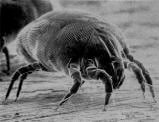Dust Mite Relief
7 Easy Ways to Control Your Dust Mite Allergy

Dust mites are an extremely common allergen. They are found all over the United States. They thrive in peoples homes, particularly in bedrooms and other frequently used rooms. You can find them in mattresses, carpets, drapes, upholstered furniture, towels, clothing and stuffed animals. Their waste product causes your allergy.
There are a variety of ways you can minimize your exposure to dust mites. By minimizing your exposure, you can significantly diminish your symptoms. In fact, many people find that they can reduce or even eliminate their reliance on medication by taking the following steps to avoid exposing themselves to dust mites. A few surprisingly simple steps can really help you lead a healthier, more symptom-free life. The steps are listed below in approximate order of importance
- Encase your mattress, box springs and pillows in dust mite covers. More dust mites live in the bedroom than anywhere else in the home. They live in the bedroom because the bed and bedding makes an ideal home for dust mites. To keep them out of the bedding, you can cover your mattress, pillow, and box spring with a fabric that has pores small enough to keep dust mites and their waste products out. There are a variety of dust mite covers specially designed for this purpose.
- Wash your bedding once a week in hot water or with All Temperature AllerTech® Laundry Detergent. Although dust mite covers will keep dust mites out of your pillow and mattress, your bedding still requires weekly washing to kill the dust mites that it will continually attract. You can kill dust mites either by washing in hot water or by using a special laundry detergent that kills dust mites in all temperatures.
- Use a High Efficiency (HEPA) Air Purifier to remove allergens. The final step for most people in keeping dust mites out of their bedroom is to install a HEPA Air Purifier. Dust mites and their waste products will often become airborne and they are light enough to remain in the air indefinitely. Air Purifiers will circulate all the air through a filtration system which captures the dust mites and other allergens and holds them in the filter. HEPA filters meet a rigorous standard of capturing 99.9% of all particles that pass through them.
- Install a quality disposable filter in your central air system. While the bedroom is the focal point for dust mites, a few additional steps can keep them out of the remainder of the home. Airborne dust mites will be circulated through a central air system and can wind up in any room of the house. This is easily prevented by using a high quality disposable filter in the central air system. All central air systems require a disposable filter, so it makes sense to choose one that is effective at capturing dust mites.
- Treat all carpets, drapery, upholstery and other fabrics with a dust mite eliminator. Like bedding, carpets and fabrics make an ideal home for dust mites. Because dust mites feed on flakes of human skin, they will be found in those rooms that people use most. Sofas and carpets in family rooms are a prime spot for dust mites. You can eliminate dust mites on carpets and fabrics in those frequently used rooms by periodically applying a dust mite eliminator. They typically only need to be used monthly (or even less) and will help keep those rooms dust mite free.
- Clean thoroughly once a week with a quality HEPA vacuum. Any room with carpeting will eventually build up a population of dust mites if it is not properly vacuumed. The problem with most vacuums is that they cannot capture particles as small as dust mites, so after sucking the dust mites out of the carpet they simply shoot them back into the air. A HEPA vacuum will capture 99.9% of the dust mites that it inhales.
- Use a dehumidifier to keep the relative indoor humidity below 50%. One way to keep the growth of dust mites controlled is to maintain dry conditions in the home. Dust mites prefer high humidity. They will grow and multiply less frequently if the humidity level remains below 50%. An effective dehumidifier can keep humidity levels down.
